Steaming Fish: Flaky and Tender Secrets
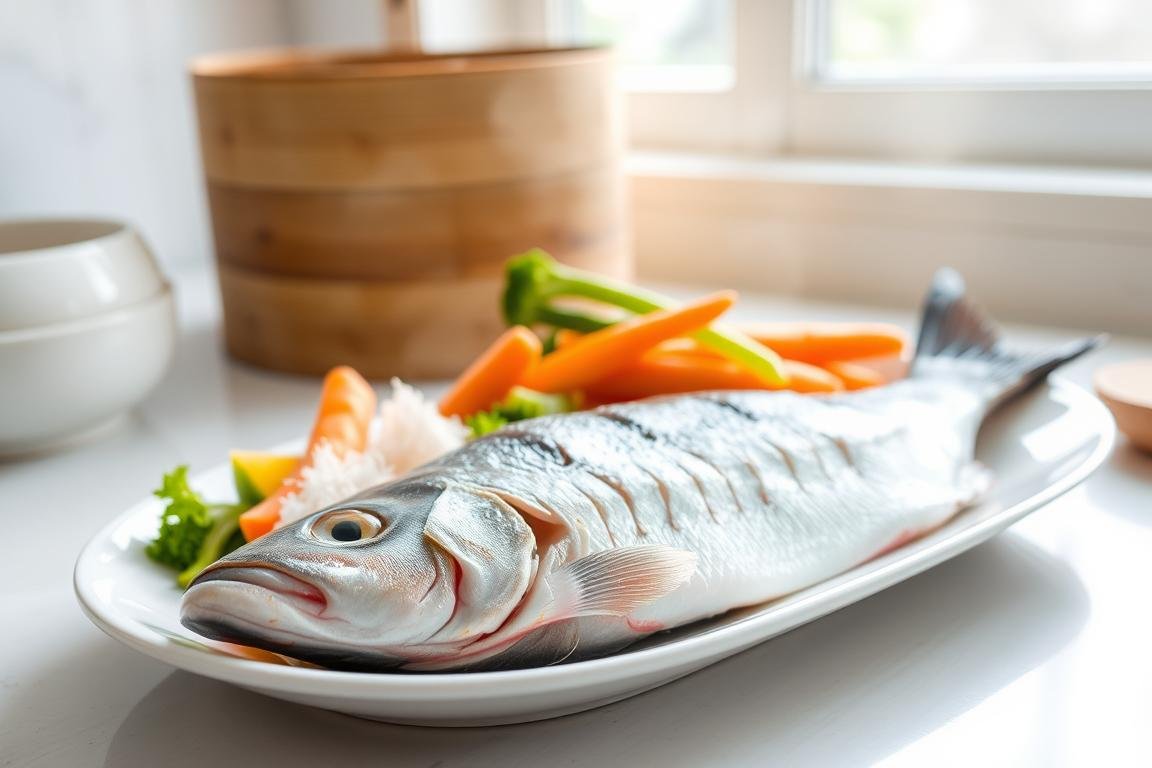
Have you wondered why top chefs love steaming fish? While many prefer frying or baking, steaming fish offers flaky tenderness. Seafood Steaming is an ancient, healthy way to cook. It turns seafood into something special.
Steaming isn’t just following steps. It’s about finding delicious Healthy Fish Recipes. Top chefs and cultures with rich food histories love it. You can find great videos online to help. Why not try this tasty and healthy cooking style?
The idea that steamed fish is boring is changing. People love the new flavors and healthy meals it offers. Dishes like Pacific Cod with tomatoes and oregano are getting popular. This shows Seafood Steaming is loved by food fans today.
Key Takeaways
- Discover the benefits of steaming, which turns the simplicity of fish into moist, flaky perfection.
- Realize the tradition-steeped method that brings health and flavor into harmony for your dishes.
- Gain insight into the six essential ingredients making up the secret soy sauce mixture that elevates steamed fish to supreme savoriness.
- Understand the optimal cooking time for different fish sizes to achieve ideal tenderness without overcooking.
- Consider the cultural and festive significance of a whole steamed fish in Chinese cuisine, symbolizing prosperity and togetherness.
- Explore popular recipes and ingredients that reflect current consumer trends and seasonal availability, informing your choice of dish.
- Engage with the growing trend of home cooks infusing personal touches to traditional recipes, indicating a surge in culinary creativity.
Why Choose Steaming for Cooking Fish?
Steaming fish is a great choice for those who love to eat well and stay healthy. It keeps the fish tender and tasty. Plus, it’s better than baking for keeping the fish’s natural moisture.
Health Benefits of Steamed Fish
Steamed fish is good for you and delicious. It’s full of protein and good fats, without needing extra oil. Steaming keeps the good stuff in the fish, like vitamins and minerals.
It helps the fish keep its color and important nutrients. This makes your meals healthier.
| Cooking Method | Nutrient Retention | Texture |
|---|---|---|
| Steaming | High | Moist and tender |
| Boiling | Low | Watery and bland |
| Baking | Medium | Often dry |
Flavor Enhancement Through Steaming
Steaming does more than just keep the fish healthy; it makes it taste better. It keeps the fish soft and brings out more flavor than baking. Methods like en papillote wrap the fish with herbs and spices.
This allows deep flavor to soak into the fish, making it both rich and lightly seasoned. It turns healthy fish recipes into something you really look forward to eating.
Essential Equipment for Steaming Fish
Choosing the right tools is key for seafood steaming. It ensures your fish is flavorful and tender. Whether you’re new or experienced, the right equipment is vital. This helps anyone looking to master steaming fish at home.
Types of Steamers: Baskets vs. Electric
There are two main types of steamers: Fish Steamer Baskets and electric steamers. Bamboo steamers, a traditional choice, are great for adding aroma like star anise. They can be stacked to cook multiple items. But, they may not fit larger fish types.
Electric steamers offer convenience with timers for even cooking. They are perfect for those who want ease and precision. Electric steamers remove the guesswork. This makes them great for beginners at steaming fish at home.
Choosing the Right Pot or Cooker
Choosing the best pot or cooker is key for seafood steaming. A wok is great for traditional methods. Its wide shape is perfect. It allows for enough space for good steam circulation. This helps cook the fish evenly.
For big fish, use low-profile steaming racks. These racks fit inside wide pots and can hold larger fish, unlike bamboo steamers. The racks’ design lets steam move freely. This is important for even cooking.
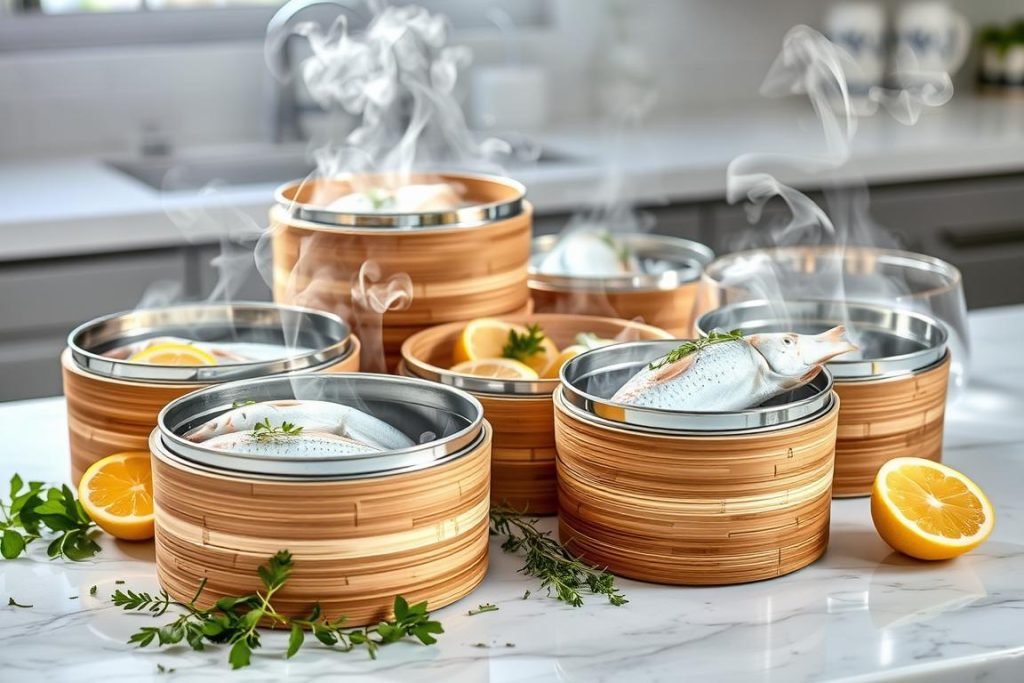
| Tool Type | Best For | Size Available | Price Point |
|---|---|---|---|
| Bamboo Steamers | Small to medium fish, dumplings | 6 to 36 inches | Varies |
| Electric Steamers | Convenience and precision | Small to large fish | Higher |
| Steaming Racks | Large whole fish | Adjustable to fit most pots | Mid-range |
Always make sure there is enough water and steam. Keep the steam level to avoid drying the fish. This is very important for larger dishes. Getting good quality Fish Steamer Baskets or the right electric steamer can make your seafood steaming better. It can turn a simple meal into something special.
Preparing Fish for Steaming
Starting with steaming fish at home means picking the best fish. Good choices include sea bass and tilapia. They’re great because they’re firm and soak up flavors well. After picking the fish, handling and seasoning it right is key to making the dish amazing.
Selecting the Right Type of Fish
When you’re new to this, choosing the right fish is crucial. Sea bass, grass carp, and flounder are top picks. They have a light taste and go well with many spices. Look for fish with clear eyes and firm flesh to ensure they’re fresh and tasty.
Essential Ingredients and Seasonings
To bring out the fish’s taste, use fresh ginger, scallions, and light soy sauce. These add depth and make the fish sweet, umami, and savory. A sauce with Shaoxing rice wine, white pepper, and sugar makes the broth better. It completes the fish’s flavor in a lovely way.
Properly Cleaning and Cutting Fish
It’s vital to clean and prepare your fish right. Start by descaling and gutting. You can have this done at places like 99 Ranch Market for best results. Then, think about the cut; whole fish symbolize good things in many cultures. Make slight cuts to cook it evenly. These cuts help the fish cook faster and taste better.
Tip: Check if the fish is done with chopsticks. If it flakes easily, it’s perfect. This prevents the fish from getting too soft.
These steps make your fish steaming techniques successful. You end up with a meal that’s tasty and healthy. It keeps its shape and flavor. So, get your steamer out and get ready for a dish that will wow everyone.
Mastering the Steaming Process
Learning Fish Steaming Techniques can make your cooking better. It’s great for Steamed Fish Dishes. To master this healthy way of cooking, you need to focus on how long you cook and the heat of the water. This keeps the fish juicy and tasty. Here are tips to help you create amazing Healthy Fish Recipes.
Ideal Water Temperature for Steaming
Getting the right water temperature is key for perfect steaming. The water needs to be boiling hard before you add your fish. This makes lots of steam to cook the fish well. The heat is balanced by the steam, so the fish stays soft.
Timing: How Long to Steam Different Fish Types
Fish sizes and thickness change how long they need to cook. A small fillet, like tilapia, cooks in 5-7 minutes. But, bigger pieces like halibut might take up to 10 minutes. Make sure the fish hits 140°F (60°C) inside. This means it’s cooked just right and still tender.
Tips for Preventing Overcooked Fish
Don’t let your fish get dry or tough. Follow these tips:
- Check your fish early to keep it from overcooking.
- Use a meat thermometer for an exact check.
- Get all your stuff ready before you start. This makes cooking go smoothly.
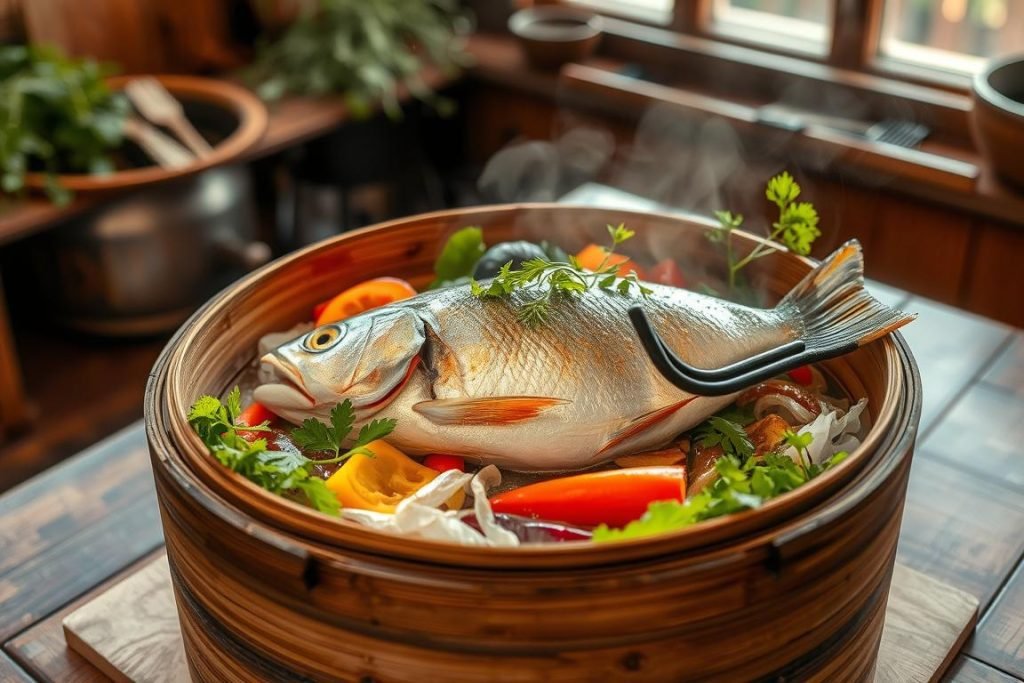
Steaming fish is about keeping it healthy, tasty, and just right. By practicing and paying attention, you’ll make great meals. The top Steamed Fish Dishes need you to be careful, patient, and love Healthy Fish Recipes.
Adding Aromatics and Flavor to Your Steamed Fish
Making your steamed fish better involves more than basic steps. By using aromatic herbs and citrus, you can make a simple meal special. You do this right from your kitchen. Learning to steam fish at home keeps the fish soft. It also makes it taste better by adding special ingredients.
Herbs that Enhance Flavor
Herbs are key to making steamed fish taste better. For a Mediterranean taste, try oregano. It has a strong flavor. Dill adds a Scandinavian taste, great with light fish. In Asia, cilantro and ginger make fish flavors interesting. Put these herbs in your steamer. They make the fish taste deep and lively.
Utilizing Citrus for Brightness
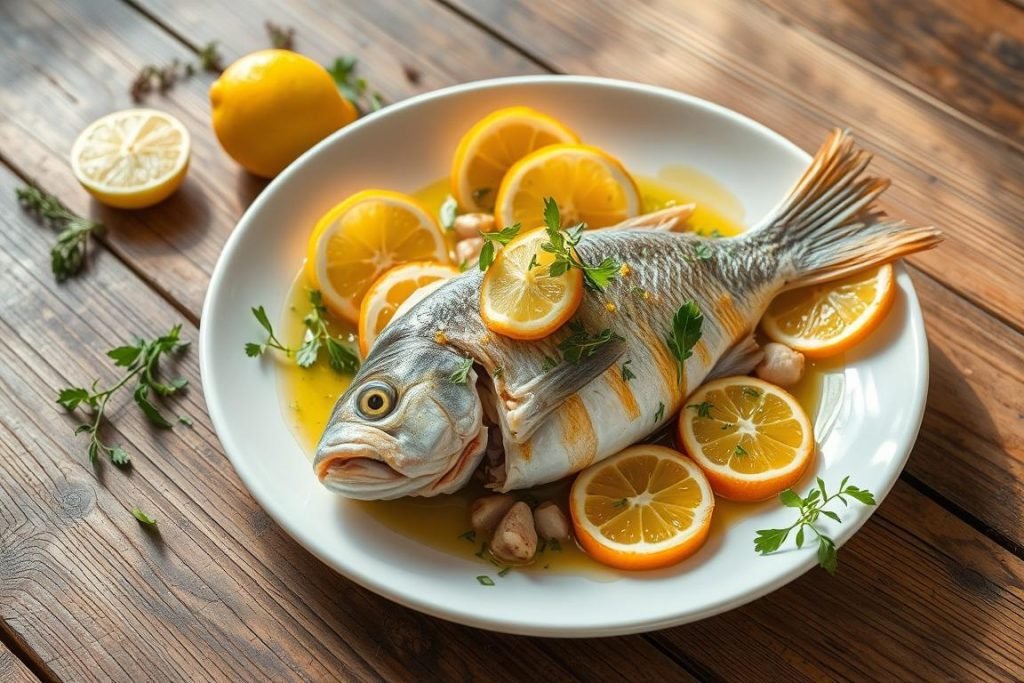
Citrus fruits like lemons and oranges make steamed fish refreshing. Put thin slices of lemon on the fish before cooking. This adds a citrus taste and looks nice. Citrus makes the fish taste lighter and better. You can also use grapefruit for a strong citrus flavor in your fish.
| Herb | Flavor Note | Best Fish Pairing |
|---|---|---|
| Oregano | Earthy and bold | Sea bass, snapper |
| Dill | Sweet and aromatic | Salmon, trout |
| Ginger | Spicy and warming | Tilapia, mackerel |
| Cilantro | Bright and lemony | Cod, hake |
When steaming fish, think of herbs and citrus as key parts. They turn simple dishes into something like restaurant quality. Mastering these can impress your friends. Your dishes will be both tasty and healthy.
Serving Suggestions for Steamed Fish
Mastering seafood steaming is just the start. Presenting your fish dishes well is the next step. It makes meals exciting, whether it’s for family or friends. Here are some side dishes and tips for serving. They make your steamed fish even more special.
Side Dishes that Complement Steamed Fish
- Vegetables: Light vegetables like steamed asparagus or sautéed spinach are great with fish. They add nutrition and taste without overpowering the fish.
- Grains: Try quinoa, couscous, or jasmine rice. They soak up the fish juices, making their flavors even better.
- Salads: A crisp salad with a light dressing adds a fresh touch to the tender fish.
Creative Plating Ideas to Impress Guests
How your food looks is important. Use these ideas to make your dishes eye-catching:
- Choose white or light plates to make your fish stand out. This highlights the colors of the fish and garnishes.
- Place the fish on a small heap of grains or next to vegetables. This makes the plate look full and careful.
- Add fresh herbs, lemon slices, or edible flowers for a fancy touch. It shows off your effort and skill.
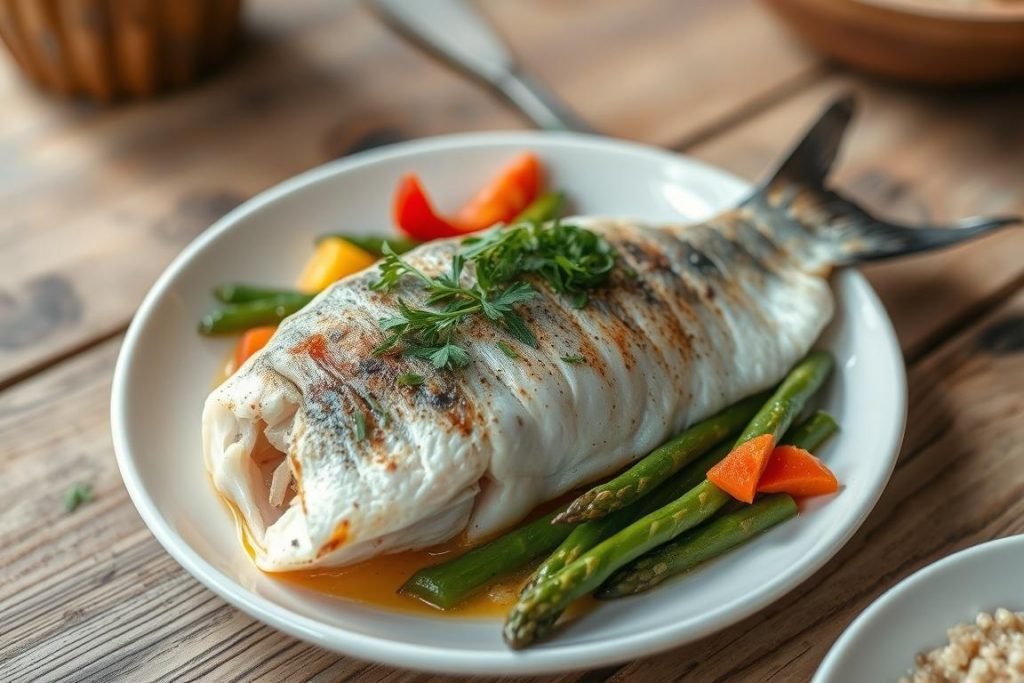
Using these presentation tips makes your meals memorable. For any event, pairing the right sides with a creative look will highlight your dishes. Your healthy fish recipes will show your great taste in seafood steaming.
Steaming Fish in Different Cuisines
Steaming fish is an art that brings out different flavors. Asian and Mediterranean methods use special ingredients. These make steaming fish a way to celebrate flavor and skill.
Asian Influences: Chinese and Japanese Techniques
Asian steamed fish is simple but meaningful. It’s big in Chinese and Japanese food. The fish stays moist and gets tasty with ginger, scallions, and soy sauce. Seafood steaming in Asia focuses on the fish’s natural flavor. It uses light spices to highlight the freshness.
Mediterranean Styles: Vibrant Flavors and Ingredients
Mediterranean steamed fish uses fresh ingredients like olive oil and lemon. These add bright flavors that match the fish’s sweetness. This method is all about fresh flavors. It values simplicity and wellness.
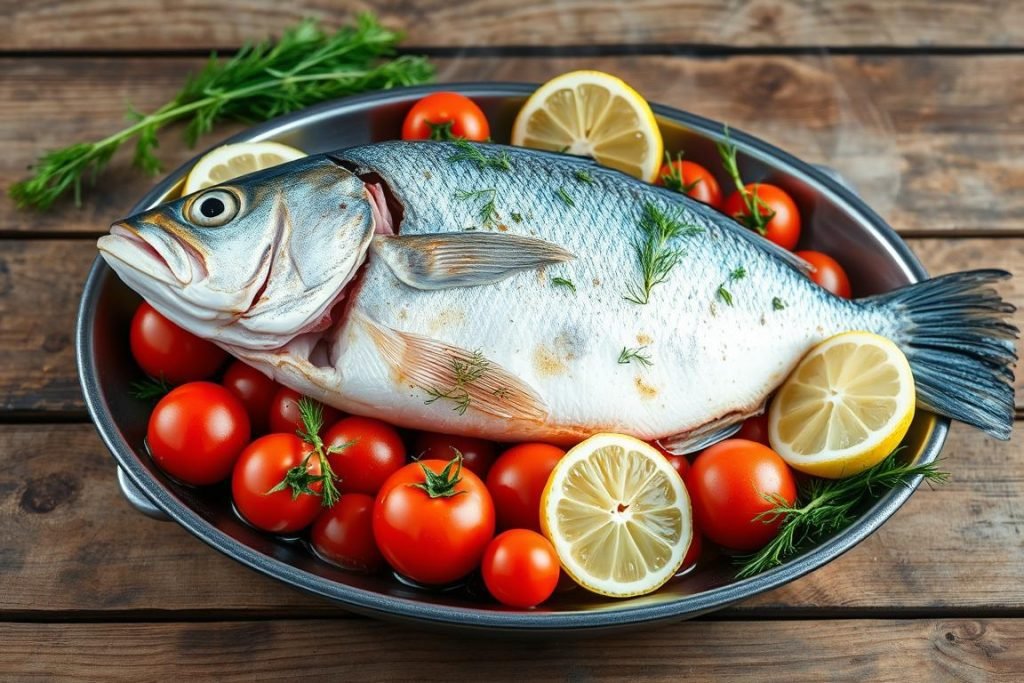
| Ingredient | Quantity | Role in Dish |
|---|---|---|
| Lime Juice | Varies | Main flavor enhancer |
| Garlic | 4 cloves, minced | Aromatic |
| Thai Chilies | 6 Thai bird’s eye chilies | Heat element |
| Fish Sauce | To taste | Salty, umami depth |
| Sugar | To taste | Balance acidity |
Want gentle Asian tastes or bold Mediterranean flavors? Learning to steam seafood can bring joy. Each method lets you taste the ocean. Plus, you get to enjoy dishes filled with tradition.
The Best Fish for Steaming
Steaming is a great way to cook fish. It keeps the fish’s flavor and texture. It’s also very healthy. When looking for the best fish for steaming, it’s good to know about different fish. This knowledge helps you make healthy fish recipes.
Top Choices for Taste and Texture
Halibut, cod, and sea bass are great for steaming. Their flaky texture and mild taste take in seasonings well. Barramundi and snapper also work well. They stay moist and tasty. Blue eye cod and pollock are good for those who like their fish firm yet delicate.
Seasonal Fish Recommendations
Choosing fish by season means better taste and it’s better for our planet. In summer, go for tilapia and basa. They’re light and good with summer flavors. In winter, try hake or jewfish. They’re strong enough for rich winter spices.
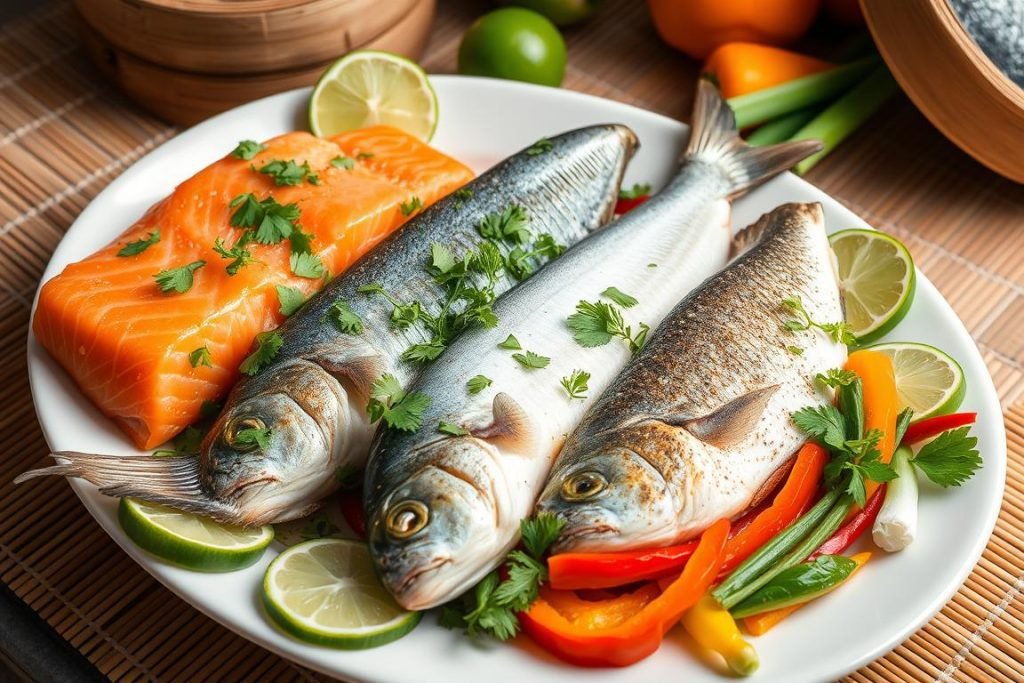
It’s not just about fish types. Think about the spices and ways to steam. Like the Cantonese way, using ginger and spring onion. It’s about making the fish taste its best by steaming.
| Fish Type | Texture | Seasonality | Typical Recipe | Approximate Market Cost |
|---|---|---|---|---|
| Halibut | Flaky and Tender | Spring-Fall | Cantonese Steamed Halibut | $18 per lb |
| Sea Bass | Delicate and Moist | All Year | Steamed Sea Bass with Ginger | $22 per lb |
| Snapper | Firm | Summer-Winter | Sizzling Ginger Snapper | $16 per lb |
| Pollock | Semi-Firm | All Year | Simple Steamed Pollock | $14 per lb |
Picking the best fish for steaming for your taste and season is key. It makes healthy fish recipes more exciting. And it makes steam cooking something you will enjoy.
Troubleshooting Common Steaming Issues
Even skilled cooks can find steaming fish at home hard. Challenges like overcooked textures and weird tastes can happen. Let’s look at how to make steamed fish dishes perfect every time.
What to Do If Fish Is Overcooked
Steaming should make fish moist and flaky. But, if it gets dry, don’t worry! Adding a light broth or citrus sauce can save the meal. It brings moisture back and stops the fish from being too tough.
Fixing Off-Flavors or Smell in Steamed Fish
Bad smells or tastes can ruin steamed fish. These problems often come from not using fresh fish or the right herbs. Always start with fresh fish and herbs. Make sure to clean and dry your fish well before cooking.

| Issue | Solution | Consideration |
|---|---|---|
| Dry, Overcooked Fish | Add moist sauce (citrus/broth) | Immediately address overcooking to prevent texture from worsening. |
| Off-Flavor/Scent | Use only fresh, well-cleaned fish and aromatics. | Review the quality and freshness of all ingredients prior to steaming. |
By using the right techniques, you can fix common problems. This makes your fishing steaming techniques lead to tasty steamed fish dishes every time.
Nutritional Value of Steamed Fish
Looking at steamed fish nutrition facts, we see why it’s loved. Steaming your fish keeps flavor and nutrients. It’s better than baking or frying.
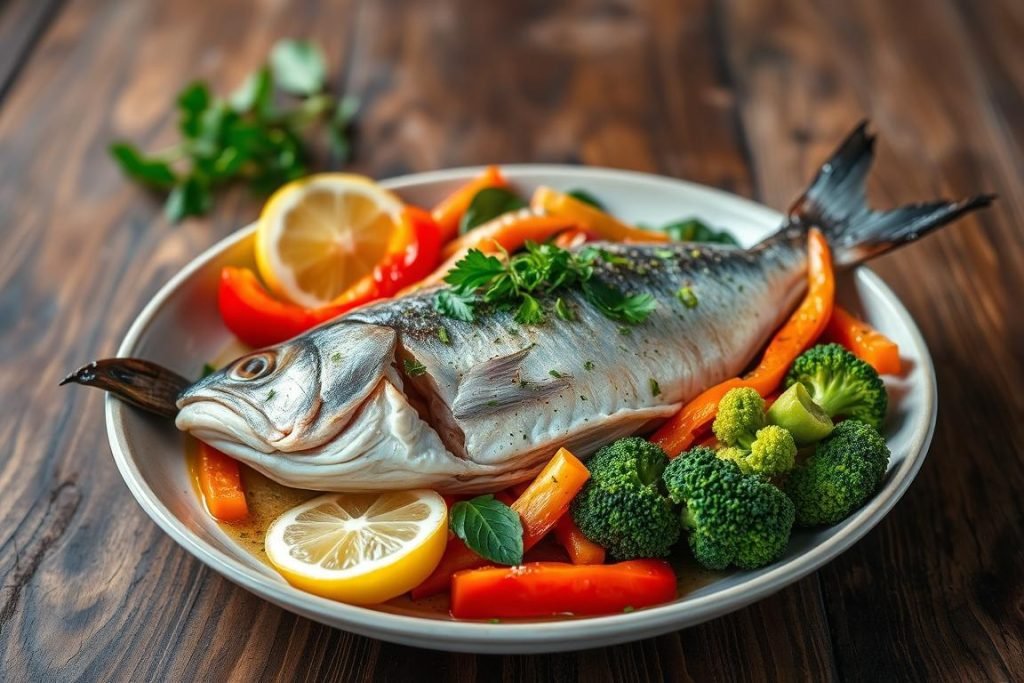
Protein and Healthy Fats in Steamed Fish
Steamed fish is tender and packed with good stuff. It gives you high-quality protein for muscles. Steamed fish is full of omega-3s which are good for the heart.
This cooking way keeps the omega-3s safe better than baking or frying.
Comparing Steamed Fish with Other Cooking Methods
Steaming vs. baking fish shows steaming wins. It keeps the fish’s texture and good nutrients. Baking or frying can make fish oily or dry. Steaming locks in moisture and taste. It cooks the fish gently and keeps it whole.
| Cooking Method | Calories | Protein | Fat |
|---|---|---|---|
| Steaming | Low | High | Low |
| Baking | Medium | Medium | Medium |
| Frying | High | Low | High |
Choosing to steam fish is smart. It makes your meal nutritious and tasty.
Fish Safety and Sustainability
As a culinary enthusiast looking to prepare healthy fish recipes, understanding fish safety and sustainability is crucial. Ensuring you select sustainable seafood not only supports eco-friendly fishing practices but also contributes to healthier oceans and fish populations. Equally, proper handling and storage of fish enhance the steamed fish nutrition content and ensure safety in your delicious dishes.

Choosing Sustainable Fish Options
Choosing sustainable seafood means picking fish that are plentiful and harvested in ways that help the environment. This approach keeps the ocean’s balance and helps local people too. Always look for labels like the Marine Stewardship Council (MSC) or use the Seafood Watch program by the Monterey Bay Aquarium to make good choices.
Safe Handling and Storage Practices
Storing and handling seafood the right way is key to keeping it fresh and safe. Here are some important tips:
- Always store fish and shellfish in the coldest part of your refrigerator or on ice if immediate cooking isn’t planned.
- Ensure seafood is stored at proper temperatures to prevent spoilage and maintain freshness. Seafood should never be left at room temperature for extended periods.
- Prevent cross-contamination by keeping raw and cooked seafood separate during preparation and storage.
- Thawing should ideally be done in the refrigerator to minimize bacterial growth. Expedited thawing can be done under cold running water or in the microwave if you plan to cook immediately.
- Cook seafood thoroughly to an internal temperature of 145°F to eliminate harmful bacteria and parasites.
- Consume or freeze leftovers within recommended time frames to avoid spoilage.
Following these practices ensures your steamed fish nutrition stays high. It also matches up with sustainable seafood choices. This way, you get healthy fish recipes that are good for you and the planet.
Recipes to Try: Steamed Fish Delight
Looking for healthier, tasty food? Try steaming fish. The Steamed Fish Delight recipe is a hit, with over 55.3K shares. It’s easy and delicious. This dish combines grouper with ginger and scallions. It takes only 30 minutes to make.
Classic Lemon-Ginger Steamed Salmon
The Lemon-Ginger Steamed Salmon is another great choice. This dish shows off Mediterranean flavors. It’s healthy too. Salmon, usually baked, works well steamed with lemon and ginger. Add carrots and dried shiitake mushrooms for more taste and a pretty look.
Asian-Style Steamed Tilapia with Soy Sauce and Scallions
Try the Asian-Style Steamed Tilapia if you love steamed fish. It’s popular for a good reason. The mix of ginger, garlic, soy sauce, and sesame oil makes it delicious. Don’t worry if it seems hard. There’s a tutorial you can watch. The recipe is detailed, with steps for a juicy 1.1 lb fish. This dish is also a symbol of luck in Chinese culture, especially during the New Year.